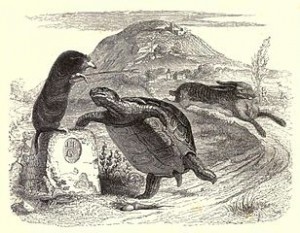Pacing 1: The Right Mix of Tortoise and Hare

Creative Commons License. Source GRANDVILLE Jean, illustration from the 1855 edition of La Fontaine’s Fables
In my survey of your biggest rewriting challenges, many of you indicated pacing of your story among the most difficult.
What is Pacing?
Pacing refers to how slowly or quickly time passes in the story: the pace of time’s passage.
It’s important to realize that pacing is not constant over the course of a story or novel. You may want to speed up time in some places or slow it down in others. The first challenge is knowing where to do so. The second challenge is showing the correct pacing.
Fast Pacing
You’ve certainly read a book that kept you glued to the page, barely able to turn pages fast enough to keep up with the action. Some authors keep the frenetic pacing across chapters so you can barely find a place to breathe, take a break or relax.
If you’re writing an action/thriller that’s all well and good, but fast pacing doesn’t give you much time to analyze the thoughts, feelings or reactions of your characters. Fast pacing focuses on a rapid-fire series of events. It’s all about the action.
Slow Pacing
You’ve also read books were it seems nothing ever happens. The characters wander through the story having feelings, emotions and inner monologues. You know them extremely well, but they don’t do anything.
Of if the characters are doing something, the POV character spends so much time analyzing every single motion, every grain of sand on the beach or every polka dot on someone’s dress, that the details may overwhelm the action.
Slow pacing lets you explore characterization, emotions and reactions. It also lets you include more setting and description.

Creative Commons License
The Right Mix
Very few stories are all action or all reaction and description. A well-paced story includes sections of both fast- and slow-paced scenes. How do you choose which scenes should be fast, and which slow?
Let’s separate scenes into two kinds: action and reaction. Some writers call these scene and sequel. The first type is faster-paced, full of action and moves the plot of the story along. The sequel or reaction is a slower-paced scene that allows your characters to reflect or react to the previous action or plot development. In such scenes, you can take more time with thoughts and emotions.
Think about a roller coaster. It inches up the first hill, giving you time to anticipate the thrill of that first big hill. The contrast between the slow and the fast sections of the ride–or your story–will add to the reader’s enjoyment. For example you may find that slowing the pace down just before a big scene will add to the suspense and to the effect of the action or revelation in the big scene.
How to Speed the Pace
Use punctuation and sentence structure to increase the pace of the action. Shorter sentences, fewer details and more dialogue can convey a fast pace. Watch that you don’t use too many short or one-word sentences. Vary the sentence style and length or you can over do the speed and lose some clarity.
“What was that?”
“A car back–”
Bang!
“That was not a car.”
“Tom, someone’s shooting at us!”
He grabbed her hand and pulled her down, away from the window.
“Call the cops, Mary. Now.” Tom let go and raced toward the door. His heart pounded.
There’s not much description here, but you get the idea of what’s going on pretty well without it.
How to Slow the Pace
When you use longer sentences, more complex sentences, emotion and reactions, you will slow the pace down. Let’s revisit the scene above where Tom left Mary after they heard shots outside the house.
Mary watched Tom go out the back door. Who was shooting at them and why? What had Tom gotten himself into this time around? Since he’d quite the force and set up shop as a private investigator, it had been one problem after another. At this point, Mary was never sure whether he’d come home each evening. She lay awake every night wondering whether she’d get a call or a knock at the door to let her know he wouldn’t be coming home again. Ever.
Two more shots rang out and echoed around the room. Tom had flipped the lights off as he left and Mary sat on the floor near the window in the dark, cold from the tiled floor seeping into her body and leaving her shivering with fear and dread. Her fingers trembled as she played with the hem of her dress. She bit her lip until she tasted blood.
Making Choices
Have you read a story where you knew more about what kind of wallpaper there was in the character’s kitchen than you did about how she felt when her husband left her? What about a story that seems to be a list of everything the character did from the moment she woke up until she fell asleep that night?
Another aspect of pacing involves deciding what scenes or actions you can leave out of a story. This will vary by genre, but in general it’s not necessary to include every movement and detail in a story and you don’t need to go completely linearly and chronologically.
You’ll want to be sure to include more details only if they 1) add to the story and 2) work for that particular character’s POV. You can absolutely bring in characterization by what details a character notices, and how he responds to them.
For example, if your MC is a police detective in pursuit of a speeding car, he’s not going to notice the landscaping of the houses they drive past, unless of course the fleeing suspect drives into the middle of a neighbor’s lawn and ends up in the fountain.
If someone’s dress or perfume or some other seemingly insignificant detail reminds your MC of a past event or brings out some characterization, then include them—sparingly.
He entered the house and the aroma of gingerbread made him feel like he was five years old again, walking into his grandmother’s kitchen.
You can and should skip any details—description or action—that doesn’t add to the story or characterization. When finishing a scene or chapter, ask yourself, what’s the next important thing that happens to this character? If it happens to be a day or a week later, then there’s no reason to include the intervening time frame—at least for him. If something important happens to another character, then include the scene, in that other character’s POV.
I’ll revisit the issue of pacing later, but I hope that this helps you make some important decisions about when to speed or slow the passage of time. Feel free to ask questions, or bring up specific examples where you’re not sure about how to pace a scene or chapter.
